
Official Edgar Rice Burroughs Tribute and Weekly Webzine Site
Since 1996 ~ Over 10,000 Webpages in Archive
Volume 0447
presents
Chattering from the Shoulder #16


Edgar and the Lions
By David Arthur Adams



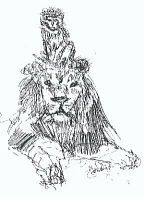 |
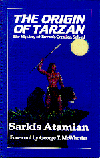
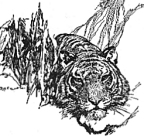
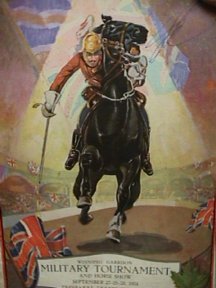
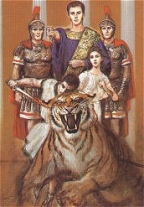
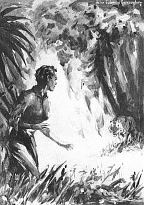
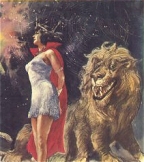
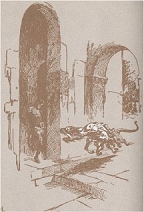 |
Anyone writing about ERB and lions has to mention his famous gaffe
of placing tigers in Africa. Commentators have done as much as they
possibly can to dispel the mistake of Sabor, the tiger, The Origin
of Tarzan: The Mystery of ‘Tarzan’s Creation Solved
by Sarkis
Atamian being the most recent attempt.
It is a bit disconcerting to read Tarzan of the Apes in the original pulp version and find Sabor the tiger instead of Sabor the lioness in so many passages. Even more startling is the fact that Sabor the tiger is a male, so he went through a gender change as well when ERB made the corrections for his book edition. Atamian traces the name, Sabor, to one of ERB’s modes of thinking -- the rule of alteration where a word is left substantially intact with its original core of meaning. “Why Sabor and not some other name? Every school child knows about the saber-toothed tiger, because of its saber-like teeth. But the saber (or sabre) is also a cavalry sword used by soldiers in the din and fury of the battlefield. To say Saber the Tiger (or Lioness) may create a perceptual dissonance since the tiger or lioness is a stealthy, quiet, stalking, slinking beast symbolizing the opposite of battlefield din and clamor. So ERB changes the “e” to “o” and makes it Sabor (Atamian, 62). It is likely that ERB’s name for a male lion, a Numa, was derived from the Roman King, Numa Pompilius, whom Burroughs would remember from reading Livy’s History of Early Rome. Livy tells us that “Numa Pompilius had a great reputation at this time for justice and piety.” He was the first king to rule Rome after the legendary founding by Romulus. His reign lasted from 715-672 B.C. Numa was the law-giver of Rome. His first act was to divide the year into twelve lunar months, and he appointed virgin priestesses for the service of Vesta. Livy sees Romulus and Numa as the important founders of Roman power -- Romulus by war and Numa by peace. “When Numa died, Rome by the twin disciplines of peace and war was as eminent for self-mastery as for military power (Livy, 35). Burroughs wrote only two stories in his Tarzan series without the appearance
of a lion in at least one scene. Tarzan at the Earth’s Core
features the saber-tooth tigers of Pellucidar and there are only tigers
in Tarzan and "The Foreign Legion", which is quite understandable
since the story takes place in Sumatra.
The lion was such a strong beast-villain for ERB that he created another
version of his own to inhabit Mars -- the Barsoomian lion, which he called
a banth. It is particularly fierce lion, briefly described by Brady
as “hairless except for a large, bristly mane around its thick neck.
It has a long, muscular body and ten legs. Its mouth reaches back
behind its ears, which are very small, and it has three rows of needle-like
teeth, much as does a calot. It has huge, protruding green eyes and
its body is a tawny yellow color.”
The banth is not introduced until the second book in the Mars Series,
The
Gods of Mars. John Carter and Tars Tarkas fight off a host
of banths in “The Chamber of Mystery” where they meet Thuvia, who
has the uncanny ability to tame these fierce creatures by the sound of
her voice. Banths appear in the next four novels, Warlord,
Thuvia, Chessmen, and Master Mind, but they are absent
from the rest, except for a mention as being on exhibit in the zoo at Amhor
in Synthetic Men. Kormal is a huge Barsoomian banth
that has come to be worshipped as a god by the nearly extinct race of Lothar
in Thuvia, Maid of Mars.
Perhaps at least a note in passing should be made of the Cat Men of Ladan in The Swords of Mars. They have a strange purring, mewing kind of language which they use among themselves, and although a ferocious race, the Masenas can be friendly and frequently quite playful in a cat-like manner. The little six-legged domestic animals called, Soraks, are Barsoomian cats. It seems that Burroughs cannot create a new world without creating new
lions to go with it. It is rather curious that he tends to place
stripes upon his imaginary lions, perhaps playing with the “mistake” in
Tarzan
of the Apes.
|
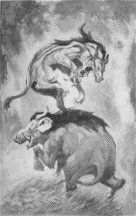
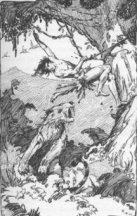
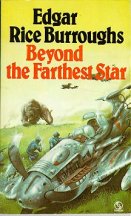
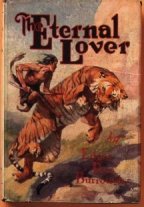 |
Here is a brief list of most of them:
The Tharban on Venus (Amtor) is a ferocious lion-like man-eating creature. It is much larger than the African lion and has a red coat striped lengthwise with white stripes. The hair of their coats is like stiff bristle, and the belly has a bluish tinge. The Tharban has enormous jaws, fangs and talons. It has a horse-like mane, and ‘a most abominable disposition and an insatiable appetite’ (Day, 77). “Ta-Ho” in Pellucidarian is the huge cave lion of the Inner World. They are generally found in a wild state, but they have been domesticated by a single tribe of Gilaks. (Day, 79). There is also the Tarag, the huge saber-tooth tiger and the Saber-Tooth Men in Pellucidar who feed on human flesh. (Day, 114). The Lion of Poloda is one of the many ferocious carnivorous man-eating beasts that inhabit the Mountains of Loras in Unis on the planet of Poloda. The “lions” are larger than the lions of Earth but rather similar in appearance except that they are striped like a Zebra. (Day, 79). Oo is the gigantic saber-toothed tiger of the stone age found in The Eternal Lover. It is as large as a full-grown bull with vivid black stripes on a bright yellow background. His canine fangs measure eighteen inches. (Day, 97). The Panther of Caspak is of such size and ferocity it may be mistaken for the prehistoric saber-tooth tiger. (Day, 102.) Zor is the prehistoric cave lion of the Niocene Age. It is rather like the African lion, but three times the size and ferocity of that modern beast. (Day, 146).
According to Cirlot’s Dictionary of Symbols ,” the lion corresponds principally to gold or the ‘subterranean sun,’ and to the sun itself, and hence it is found as a symbol of sun-gods such as Mithras.” (Cirlot, 180) Tarzan is quite logically connected to the lion in this sense with his companion, Jad-bal-ja, the golden lion, his own status as a “demigod,” and with his journey to Pellucidar, which ERB tells us was “heaven” to him. “For Jung, the lion, in its wild-state is broadly speaking an index of latent passions; it may also take the for of a sign indicating the danger of being devoured by the unconscious . . . The wild lioness is a symbol of the Magna Mater (the Great Mother, who in antiquity was the symbol of the furnace, or womb, and the universal queen or anima mundi, the world’s soul.) (Cirlot, 180-181). Both the male and female lion play an important part in Tarzan’s life, as may be seen in my “Soul of the Lion” first published in ERBapa in 1995. |

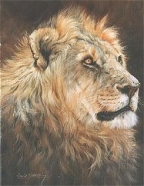
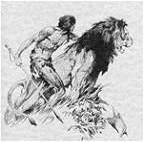
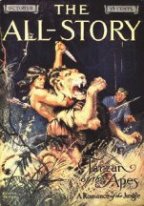
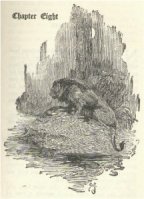 |
Sabor, the lioness, was of course a male tiger in the original version
of Tarzan of the
Apes, but the sex change which occurred with the species change
in his later corrections for the book edition also changed the symbolic
role of this new female cat as well as her literary weight. Burroughs
employed Sabor in her symbolic role as Magna Mater in his Son of
Tarzan, Jungle Tales, and Tarzan and the Golden Lion.
There is no doubt that ERB’s Sabor as a male tiger in the first version of Tarzan of the Apes makes a symbolic reading of the lioness this book problematical, but it certainly does not remove the validity of such a reading since lions are extremely important in this book and the rest of the series. It seems likely that Kipling’s Shere Kahn, the tiger, was ERB’s inspiration for his Sabor. Even Atamian is willing to give Kipling this much: “ (Burroughs) was generally influenced, or more correctly, inspired, by Kipling, but not specifically in Tarzan’s creation (Atamian, 30). The lion played its role in Greek and Roman mythology, which was as much an influence on Burroughs as Kipling. The first of the twelve labors of Hercules (or “Heracles” as Graves correctly spells it since it means “Glory of Hera”) was to kill and flay the Nemean or Cleonaean lion, an enormous beast with a pelt proof against iron, bronze, and stone. After trying to slay the beast with arrows, his sword, and his club, he finally choked it to death. (Graves, 103-104). Of course, this reminds the ERB fan of Tarzan’s battle with Sabor at the window of his cabin in chapter 15 of Apes where he kills Sabor (the tiger) with his bare hands, employing a “full Nelson” and breaking his/her neck. Burroughs tells us that “Clayton saw a thing done which not even the eternal heavens had ever seen before,” but he certainly knew about Heracles and Samson (who repeated the feat in the Hebrew version of this tale). Since Burroughs knew of these previous stories, he was not pointing out the exclusiveness of Tarzan’s feat, but calling upon the eternal heavens to observe how his character now joins in that immortal band. Heracles skinned the lion, using its own claws for the otherwise impossible task, and wore the invulnerable pelt as armor, and the head as a helmet. (Graves, 105). Tarzan’s pelt of Sabor dried out and became as stiff as a board before he could use it, which demonstrates the fact that he had chosen the wrong symbolic dress. Tarzan was to be garbed most of the time in a leopard skin, although he did wear a lion pelt upon occasions. In story # 8 Jungle Tales of Tarzan, the Ape-man is nearly killed by the members of his tribe when he appears dressed in a lion pelt. Later in story #11 “Jungle Joke” Tarzan plays the lion skin trick again, but this time on the cannibals to a good effect when he pulls a switch and frees a real lion into the village. The natives come to believe that Tarzan is able to change himself from a lion to a man, and back again into a lion, which of course is one of the main Tarzanic themes -- a man divided between two natures. (Burroughs, JT, 292). |


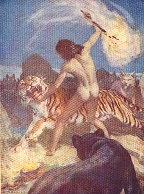

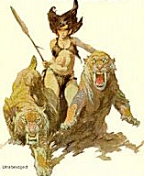
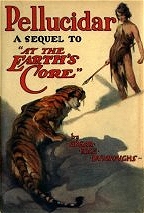 |
Kipling’s Mowgli too shares this struggle between life in the wild
and life among his own kind. Rather than dispute about influences
or inspiration, it is more fruitful to look at the stories and see where
they bear comparison with each other, especially in relation to Sabor,
the tiger.
Mowgli too desires the pelt of the tiger, but not to wear as did Tarzan. When Shere Khan’s striped hide was taken by Mowgli, it was spread out on Council Rock and he sang and danced upon it, “leaping up and down on the rattling skin, and beating time with his heels till he had no more breath left” (Kipling, 90). Thus, he performed a ritual celebrating the death of the tiger, one might say, a private Dum-Dum, to mark the defeat of his enemy. Bonamy Dobree points out in his introduction to the Easton Press edition of The Jungle Book that “Mowgli was acutely aware of being torn between two races, both of which had cast him out -- a bitter realization he expressed in his “Song” which comes after the story, “Tiger! Tiger!” The last three lines go as follows: “I am two Mowglis, but the hide of Shere Kahn is under my feet. All the jungle knows that I have killed Shere Kahn. Look -- look well, O Wolves! Ahae! My heart is heavy with the things that I do not understand.” (Kipling, xv). When Mowgli brings the pelt to his Mother Wolf to show her his victory she says, “I told him on that day, when he crammed his head and shoulders into this cave, hunting for thy life, Little Frog -- I told him that the hunter would be the hunted. It is well done” (Kipling 89). This episode refers to the first Mowgli story, “Mowgli’s Brothers” where Shere Kahn came to claim his prey (Mowgli) who has just escaped him. The tiger pushed his great square head and shoulders into the cave entrance where Mowgli had found shelter with the wolves. It seems possible that there might have been a distant memory of Kipling’s story at work in chapter 15 of Apes called “The Forest God” when Tarzan drew Sabor the tiger out of the window of his cabin when he was trying to kill Jane and her maid. Kipling’s picture of a tiger sticking his head into a cave to look at the child is a forceful one, and one twice repeated in Kipling’s accounts. In ERB’s story, the double mention of head and shoulders is the telling point. Tarzan pulls Sabor back out of the window ‘until the great shoulders came clear.” Jane is surprised, and in the moonlight beyond she saw “the heads and shoulders” of two men. This scene may or may not be an artistic transposition of something ERB read many years past. The sources for images that come to a writer can not often be found, but this one of the tiger poking his head and shoulders into a tiny opening seems to ring true to me given the forcefulness of the image. |
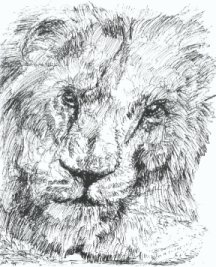 |
Bibliography
Adams, David, “The Soul of the Lion,” ERBapa
# 47, Fall, 1995.
Atamian, Sarkis, The Origin of Tarzan:
The Mystery of Tarzan’s Creation Solved, Publication Consultants,
1997.
Brady, Clark A., The Burroughs Cyclopaedia,
McFarland, 1996.
Burroughs, Edgar Rice, Tarzan of
the Apes.
----------------------- Jungle
Tales of Tarzan
Cirlot, J.E., A Dictionary of Symbols,
Philosophical Library, 1962.
Day, David, The Burroughs Bestiary,
NEL, 1978.
Fabricius, Johannes, Alchemy: The
Medieval Alchemists and Their Royal Art, Diamond Books, 1994.
Graves, Robert, The Greek Myths,
Pelican, 1955.
Kipling, Rudyard, The Jungle Books,
Easton Press, 1980.
Livy, (Titus Livius), The History of Early
Rome, Easton Press, 1978.
The End
![]()
ERBzine Lion References
ERBzine 0071: Man-Eaters
by Edgar Rice Burroughs ~ 1937
ERBzine 0239:
Nkima's Icons and ERB
ERBzine 0240: Numa's
Lair Pt. 1 with a Guide to our St. John Sites
ERBzine 0448: Numa's
Lair Pt. 2
ERBzine 0396: Contents
page for the entire Nkima Chats series
![]()
![]()
![]()
Volume
0447
![]()

![]()
BILL
HILLMAN
Visit
our thousands of other sites at:
BILL
AND SUE-ON HILLMAN ECLECTIC STUDIO
All
ERB Images© and Tarzan® are Copyright ERB, Inc.- All Rights Reserved.
All
Original Work © 1996-2006/2010 by Bill Hillman and/or Contributing
Authors/Owners
No
part of this web site may be reproduced without permission from the respective
owners.